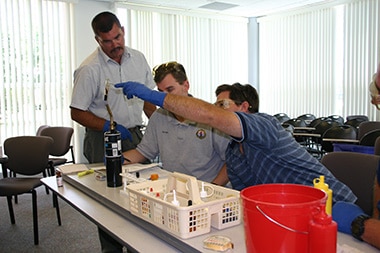The most important components of producing a valued hazard analysis are the material’s physical properties and chemical hazards. The importance of analyzing the appropriate information is astronomical, as it tells a technician how the product will move and its hazards relating to flammability, pH, toxicity, and reactivity. Unfortunately, many Hazardous Materials teams and individual technicians overlook the importance of chemistry training for in-field assessment. This is often due to their reluctance to take on a subject that is so broad and technical in nature. It is, for many, a scary but very necessary endeavor. Luckily, at Response Technologies, we understand the various schools of thought as to how much chemistry is needed to properly make that hazard analysis. You can get too little (just enough information to give you a false sense of security), too much (enough to make you wish you have never heard the word chemistry before), or just the right amount of information to allow you to make confident and safe decisions in the street. Imperial college chemistry focuses on teaching you how new compounds are made, while what we like to call “street chemistry” focuses more upon what happens when the product comes out of its container and threatens to hurt or harm those things that it contacts. (credit to Ludwig Benner for that approximate quote)
In The National Fire Academy’s Chemistry for Emergency Response program, a gold standard since the 1980’s, responders are prepared to function safely at the scene of a hazardous materials incident by understanding the potential hazards. This is accomplished by gaining recognition of chemical nomenclature and basic principles of chemistry in order to assess risks to both responders and the public. This is done through a 10 day on-campus course that includes problem-solving sessions and interactive discussions to cover topics such as salts and inorganic nonsalts, hydrocarbons, hydrocarbon radicals and derivatives. This program exceeds chemistry competencies outlined in NFPA 472 “Professional Competency for Responders to Hazardous Materials/WMD Incidents” at the technician level, and is one of the most sought after classes offered at the National Fire Academy. For more information on signing up for a class at the National Fire Academy, visit the NFA’s website at https://www.usfa.fema.gov/training/nfa/. Response Technologies can provide for deliveries of this and other NFA programs on a local basis.
Also in the chemistry genre, Response Technologies offers several other options such as a 40 hour Hazardous Materials/Fire Chemistry as well a various field chemical analysis and risk assessment programs, all of which can be delivered at your location. For more information, see our course list at www.responsetechnologies.com.

